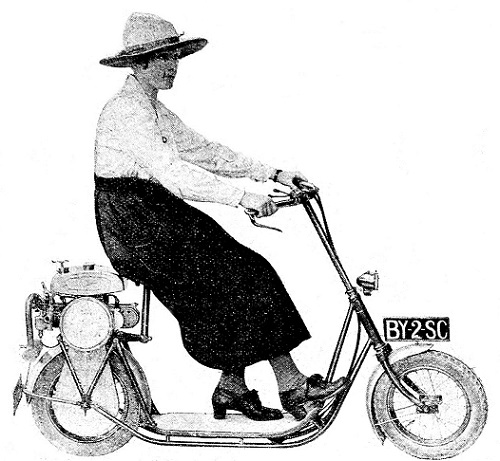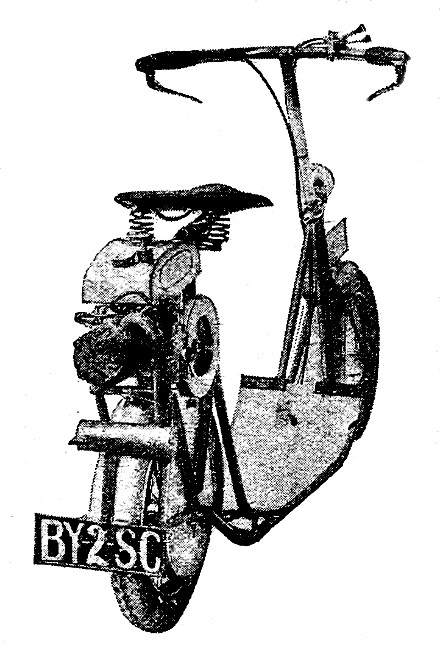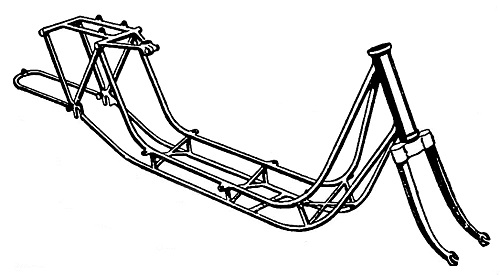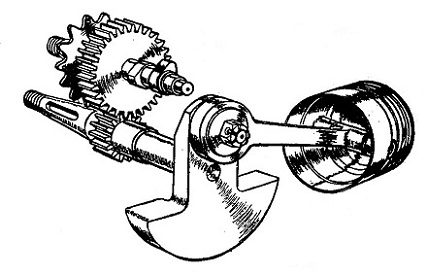The Latest A.B.C. " Skootamota" provided with a Pan Seat and now forming a Step between the Scooter Proper and the Lightweight Motor Cycle
The Motor Cycle policy in regard to scooters is well known. We have openly stated our conviction that it will eventually develop into a miniature motor bicycle - the genuine lightweight we have sought for years past. Our query, oft repeated, " Why stand? ", has remained unanswered. Surely the person who would prefer to stand on a motor-propelled platform when he or she might well adopt a comfortably seated position and progress at comparative leisure is a rarity.

An idea of the size of the A.B.C. "Skootamota" is conveyed by the photograph shown above. Incidentally, it confirms our contentions that the scooter is the ultra lightweight in embryo, for it embodies nothing which is not more or less motor cycle practice.
We have made these remarks before, since the answer to our simple question admitted of but one answer. Apart from this, we welcomed the advent of the original motor scooters, since it was clear that they would perform important missionary work by attracting to the ranks push cyclists who have hitherto regarded motor cycles as too heavy.
The natural development which we foresaw and forecasted in the columns is happening. The scooter we are about to describe can more correctly be described as a miniature motor bicycle - the genuine lightweight, in fact. It has a pan seat, an open frame permitting a coat or mackintosh to be worn by the rider, petrol capacity to give it a range of action far beyond that of the original toy scooters, and its road performances more nearly approach the lightweight motor cycle, though obviously, in the absence of a change speed gear - which may or may not represent a possibility of the future - its hill-climbing or, alternatively, its speed capabilities, are limited by the gear ratio adopted.
For some time past a considerable amount of experimental work has been carried out in the evolution of a practicable scooter by Messrs. A.B.C. Motors, Ltd., which has now reached fruition, and the new design should be ready for sale in about a month's time. Viewed through the eyes of the average motor cyclist, the A.B.C. (properly known as the A.B.C. " Skootamota ") is an extraordinarily diminutive and compact bicycle, yet directly one takes the saddle and assumes control of the machine an impression is immediately evident that it is built for ease of handling and the utmost simplicity of control.
As seen in the illustrations, theframe is of the open type, and built up of light steel tubing with welded joints, and, owing to the fact that the centre portion of the frame is dropped to a very low point, it has been possible to provide a large open space in the centre of the machine so that any tangling of dress in the case of lady riders is entirely avoided, whilst at the same time there is plenty of foot room. The frame is built up of four longitudinal tubes attached at the front to the steering head and to the triangular framework at the rear of the machine, which is built over the rear wheel and supports the power unit and pillar for the pan seat. In the centre of the frame of the scooter are three shallow X-shaped cross members made of light steel tubing, which stiffen the middle section of the framework and give additional stability in the main frame assembly.
The Power Unit.

The complete power unit of the A.B.C. scooter, showing the neat arrangement of the magneto and combined petrol and oil tank above the crank chamber. An important item is that the cylinder head complete with inletand exhaust valve assembly is detachable from the cylinder for overhauling purposes.
The engine has a single horizontal cylinder with a bore of 60 mm. and stroke of 44 mm. (125 c.c. capacity), and, although only
rated at 1¼ h.p., the engine is easily capable of giving 2½ h.p. under normal conditions. The cylinder head is detachable complete with the valves, which are mounted opposite to each other in the cylinder head casting, the exhaust valve being overhead for cooling purposes. Following A.B.C. practice, the cylinder is made of steel and turned from the solid, a flange being provided at the base so that the cylinder can be held to the crank case by four nuts.
A single-throw crankshaft with one web and balance weight is mounted in ball bearings inside the miniature crank case, and the big end provided with a roller type bearing. The piston is of cast iron, having two rings of the same material above the gudgeon pin. On the opposite side to the cylinder a small C.A.V. magneto is secured to the crank case by means of a clamp and long bolt, and is driven by a train of gear wheels from the crankshaft in a housing cast at the side of the crank chamber. The camshaft for operating the valves is mounted in ball bearings above, the crankshaft as shown in the sketch, and also carries a sprocket by which the drive is taken to the rear wheel with an enclosed ½in. x 3/16in. roller chain, the gear ratio being 10 to 1. A small steel flywheel is keyed on the outer end of the cranskhaft outside the crank case, and is also enclosed. A little single-lever automatic carburetter is fitted to the engine in an open and accessible position, and is supplied with petrol from a small tank mounted on brackets above the crank case, the feed of petrol being by gravity. Inside the tank there is a separate compartment for lubricating oil; a hand pump is fitted in this compartment by which lubricant is forced through a pipe directly to the crank case as occasion requires. The exhaust gases are taken through a short length of piping to a small silencer mounted just above the tail of the rear mudguard.
Bicycle Parts.
The steering head and front forks of this little machine follow ordinary bicycle practice in construction, with the exception that the forks themselves are very short in length, while the 16in. wire wheels are shod with 2 3/8in. tyres. Two contracting band brakes are fitted as standard, the rear brake being operated by a pedal in the front part of the footboard, whilst that in front is controlled by a grip lever on the right handle-bar. In order to give additional comfort a special pan saddle of extra width is employed, and rubber shock absorbers are fitted under the footboard on the main frame. There are also rubber supports at the front end of the board.
General Utility.

Rear of the A.B.C. "Skootamota." It will be noticed that our query, "Why stand?" is answered in Mr.Bradshaw's design.
In taking a trial run with this miniature motor bicycle (for in effect it is no other) we were pleased with the manner in which the machine could be used and controlled. It should make a distinct appeal for short journeys and general town runabout purposes, where constant stopping and starting are necessary. We found the machine comfortable to ride and able to ascend the moderate hills in the locality in which our test was made with no signs of overheating. Owing to the small overall dimensions it is possible to ride the machine through narrow spaces in comfort at three miles per hour where it would be unsafe to pilot an ordinary motor bicycle, and a great point in its favour is that it requires little effort to start while in the saddle, merely a single push of the foot being necessary.
The ease of control, in conjunction with its open frame, low weight and build, suggests possible developments for this type of machine for messenger service and parcels delivery.
This, the newest of the many A.B.C. productions, can also be used with success in journeys of some length, such as from outlying farms into neighbouring towns, largely for the reason that the rider is seated on a comfortable pan saddle instead of remaining in the standing position; it is suitable for narrow lanes, it climbs hills comfortably, and the petrol tank will hold sufficient fuel for a run of fifty miles.
A Comprehensive Equipment.
It is possible to traverse a circle of 9ft. diameter with ease, while the engine is throttled down, and since the maximum speed of this scooter is about twenty miles an hour it is possible to accomplish ten miles an hour with reasonable comfort for journeys of moderate length. As the machine, only weighs 60 lb., and is compact and easy to handle, an attractive point is that it can be stored away in any handy place in a house or shed, and is ready for use at a moment's notice.
The price of this smallest of all motor cycles, known as the A.B.C. " Scootamots," is £40, which covers the registration fee, and equipment comprising horn, tools, number-plates, electric head and tail lamps with battery. The sole rights of manufacture and distribution are held by Messrs. Gilbert Campling, Ltd., 1, Albemarle Street, Piccadilly, London, W.1.
From "The MotorCycle" - May 29th, 1919


